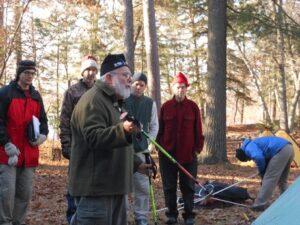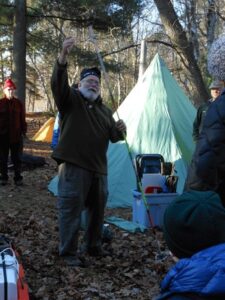Ultralight Winter Hot Tent Camping with a Standard Sled
By Ed Bouffard
In the past, SkiPulk.com has sponsored sessions of an Ultralight Winter Hot Tent Camping workshop at the Midwest Winter Camping Symposium and the Midwest Mountaineering Winter Expo. We had some excellent groups and enjoyed the opportunity to demonstrate a little thinking outside the box.
While we still enjoy winter camping in igloos and snow shelters when we have enough snow, we have also enjoyed winter camping in a hot tent. Finding a way to create an ultralight winter hot tent camping setup that would fit on a standard sled, was a way to combine both.
While many winter campers spend a lot of their time in their hot tent, we tend to spend as much time outdoors as we can. That being said, we find the shelter of a hot tent really beneficial for four factors:
- I love eating dinner after dark in a warm environment
- Settling into the sleeping bag for the night in the comfort of a hot tent is addictive
- I also enjoy waking up to a hot tent and hot breakfast
- Lastly, the most important asset of a hot tent is the ability to thoroughly dry any wet clothing, socks, gloves and boot liners
Since we do not keep our stove going after retiring for the night, we make sure to leave a stack of kindling and tinder near the stove where we can restart it while keeping most of the body in the comfort of the sleeping bag. It doesn’t take long for the new fire to re-warm the tent.
Because we are not trying to keep a fire burning all night, we do not need a large stove or really heavy tools for firewood gathering. This fact, coupled with some innovative multiple use concepts detailed below, allowed us to create our ultralight winter hot tent camping setup with a 50lb standard sled load that includes all that you need to enjoy a hot tenting experience (minus the food).
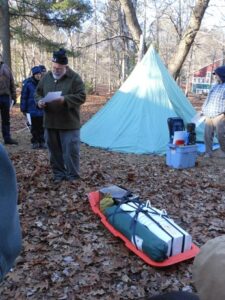
The sled included:
- Paris sled
- Tent for 4 (find instructions to sew your own lightweight DIY winter camping tipi/teepee style hot tent here)
- Wood stove & pipe
- Hatchet
- Saw & firewood nippers
- Snow shovel
- Table
- Chair
- Double down sleeping bag
- Down mat
- Down booties
- Balaclava/mittens
- Cook stove & fuel (outside)
- Pot /water pail
- Mukluks
- Waterproof storage (40 L)
- Change of wool clothes
- Lantern
For starters, the workshop demoed a simple lightweight and compact cone style DIY tipi/teepee hot tent with a single middle support pole. These tents are relatively easy to create from large tarps or by sewing fabric together to create a large rectangle that we then cut a cone shape out of. Find detailed instructions here for easily sewing your own lightweight teepee hot tent.
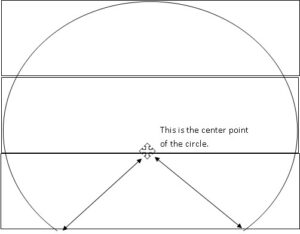
Similar commercial tents are available from Kifaru or Titanium Goat but probably the least expensive commercial option would be to put a stove jack in the Cabelas Outback Lodge tent. Our experience has shown that if you burn good wood and extend your stove pipe above the tallest part of a steep walled tepee or pyramid that we rarely get spark holes in tent fabric.
As part of the workshop we demoed creating a telescoping aluminum pole with spring buttons but also discussed alternatives that used our pulk poles or avalanche probe ski poles to replace the center pole.
For a stove we used a Four Dog titanium stove with nesting titanium pipe. Even with the double pipe set the stove only weighs about nine pounds and provided storage for a hatchet and saw. While we have used even smaller folding stoves from other vendors, we have found the airtight nature of Four Dogs stoves to be much superior in actually controlling a burn to provide the right temperature for the hot tent. To demonstrate another alternative for those who want to take advantage of more storage space in the stove, we did demo using stainless steel shim stock and wire loops to create a stove pipe similar to what you can find with collapsible stoves.
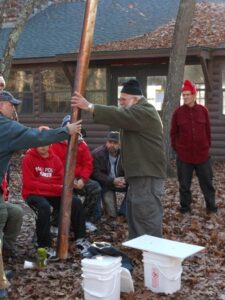
In preparing for this workshop we received a lot of assistance from Four Dog Stoves owner Don Kevilus. I was showing Don some creative designs I had come up with for “snow shoe” chairs that wouldn’t sink into the snow. Don reminded me of his principle of multiple use and it wasn’t long before I came around to “rediscover” the utility of the 5 gallon bucket chair. While trying to figure out exactly how this bucket chair could fit on a sled I came across a company that sold rectangular 20 liter buckets that fit a sled much better. Soon after acquiring a coveted supply of new buckets I was quickly schooled by my cat loving friends that these same buckets were available for about the same price plus they were full of fresh cat litter. These containers served as water proof storage, water storage, snow scoops, ‘snow shoe’ chairs and with an “alumicore” top they even served as a table for our hot tent.
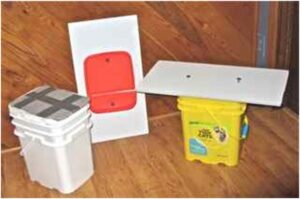
Using a similar multi use concept we quickly trimmed down our bulky firewood nipper by replacing one of the handles with the handle from the snow shovel we already had along.
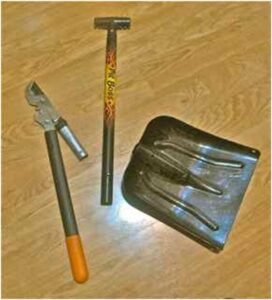
The most creative part in putting together this workshop was applying Don’s principle of multiple use to the sleeping system to achieve our ultralight setup. We all know that the secret to staying warm in the winter is the layering principle, yet most of us immediately forget layering when creating sleeping systems. For centuries winter travelers incorporated clothing they already were wearing into the sleeping system, yet we insist on bringing a stand alone huge sleeping bag. While learning from traditional knowledge I certainly love to incorporate technology when appropriate.
For our sleeping system we start with the excellent Down Mat from Exped. Since we lose most of our heat to the ground this is an incredible asset for a comfortable winter nights sleep. Around this we use the layer system. Before settling in we have already changed into our dry merino wool under garment and a down parka. By buying a lightweight outer bag with plenty of inside room, we can utilize the down parka and down booties in our sleeping system. For this purpose we chose the Exped Dream Walker. It has the added benefit of having foot and arm opening allowing it to be turned into a second overstuffed down parka. For the really cold nights we turned to something we already had in our camping locker: a nice lightweight summer down bag that can be doubled up as an inside bag focusing on keeping the lower torso warm.
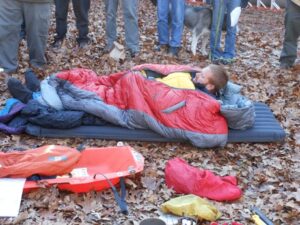
We recognize that this ultralight hot tent camping scenario isn’t for everyone. There are camping comforts that will be missed by the traditional winter camper. Yet the workshop did definitely show that it is possible to enjoy a hot tent camping experience while fitting it all on a standard sled.

